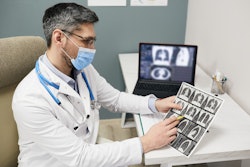
Bioelectronic medicine scientists from the Feinstein Institutes for Medical Research at Northwell Health in New York recently released study results that could one day revolutionize treatment options for patients with pulmonary arterial hypertension (PAH). The research team, led by Stefanos Zafeiropoulos, MD, PhD, and Stavros Zanos, MD, PhD, demonstrated that noninvasive, splenic-focused ultrasound stimulation (sFUS) can reduce inflammation, improve symptoms and slow progression of PAH.
The study, which was published in American Heart Association’s (AHA) Circulation Research, is the first of its kind to display efficacy in preclinical models with translational significance to PAH in humans.
“As we explore the therapeutic possibilities of bioelectronic medicine, our splenic-focused ultrasound stimulation research suggests a novel and promising approach for reducing inflammation and managing pulmonary hypertension,” Dr. Zanos said in a Northwell Health news article. Dr. Zanos is senior author of the study and associate professor in the Institute of Bioelectronic Medicine at the Feinstein Institutes. “With further preclinical investigations and clinical studies, focused ultrasound, alongside other bioelectronic medicine approaches, could become a viable treatment option for clinicians and patients."
PAH is a rare, fatal disease in which a person’s pulmonary arteries and vessels thicken, constrict and, eventually, block oxygen from the heart to the lungs. Current medications used to treat PAH may help relieve symptoms, but do not address inflammation or disease progression. This innovative study augments mounting scientific evidence of ultrasound neuromodulation and its efficacy in targeting inflammation and improving quality of life for patients with PAH and other cardiopulmonary conditions.
Drs. Zanos and Zafeiropoulos’ new research expanded upon that of Kevin J. Tracey, MD, president and CEO of the Feinstein Institutes. Dr. Tracey employed vagus nerve stimulation (VNS) to manipulate the neuroimmune pathway and suppress the body’s inflammatory response. With the same end goal in mind, Dr. Zanos’ team used sFUS to activate the pathway and reduce inflammation.
In the randomized cohort trial, the researchers administered either 12-minute sessions of sFUS or false stimulation for 14 days. The models that received sFUS showed discernable improvement in pulmonary pressure, reduction in lung inflammation and regulation of lung and heart function, as well as noticeable changes in the pathology of their pulmonary vessels. Results also showed that sFUS helped to abate progression of PAH even once treatment stopped, with amplified outcomes the longer treatment continued.
























